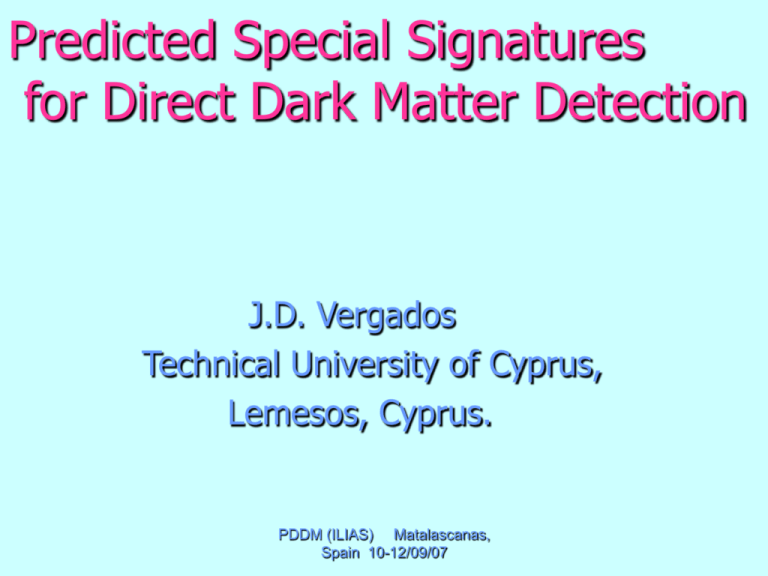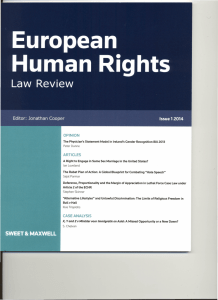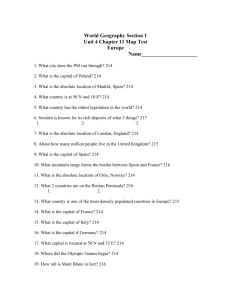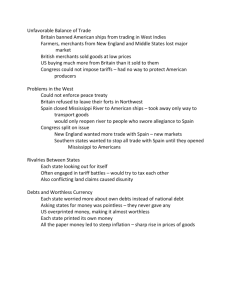Predicted Special Signatures for Direct Dark Matter Detection
advertisement

Predicted Special Signatures for Direct Dark Matter Detection J.D. Vergados Technical University of Cyprus, Lemesos, Cyprus. PDDM (ILIAS) Matalascanas, Spain 10-12/09/07 EVIDENCE FOR THE EXISTENCE OF DARK MATTER • Gravitational effects around galaxies • The recent observation of the collision of two galaxy clusters (to-day 3.5109 ly away from us, 2106 ly apart) • Cosmological Observations (confirmed by the recent WMAP3 ; together with dark energy) PDDM (ILIAS) Matalascanas, Spain 10-12/09/07 Dark Matter exists! What is the nature of dark matter? • • • • • • It is not known. However: It possesses gravitational interactions (from the rotation curves) No other long range interaction is allowed. Otherwise it would have formed “atoms” and , hence, stars etc. So It is electrically neutral It does not interact strongly (if it did, it should have already been detected) It may (hopefully!) posses some very weak interaction This will depend on the assumed theory WIMPs (Weakly Interacting Massive Particles) Such an interaction may be exploited for its direct detection The smallness of the strength of such an interaction and its low energy makes its direct detection extremely difficult. So we have to seek for its special signatures, if any. PDDM (ILIAS) Matalascanas, Spain 10-12/09/07 Such a signature is provided, e.g., by Directional Experiments We will consider the rate in a given direction of the recoiling nucleus divided by the Standard rate This will depend only on: • The WIMP Mass (the only particle parameter needed). Treated as a free parameter • The WIMP velocity distribution • The nuclear form factor PDDM (ILIAS) Matalascanas, Spain 10-12/09/07 DARK MATTER (WIMP) CANDIDATES • The axion: 10-6 eV<ma <10-3 eV • The neutrino: It is not dominant. It is not cold, not CDM. • Supersymmetric particles. Four possibilities: i) s-νετρίνο: Excluded on the basis of results of underground experiments and accelerator experiments (LEP) ii) Gravitino: Interesting possibility, but not directly detectable iii) Αxino: Intersting, but not directly detectable iv) A Majorana fermion, the neutralino or LSP (The lightest supersymmetric particle): A linear combination of the 2 neutral gauginos and the 2 neutral Higgsinos. MOST FAVORITE CANDIDATE! • Particles from Universal Extra Dimension Theories (e.g. KaluzaKlein WIMPs) • The Lightest Technibaryon, LTB (Gudnason-Kouvaris-Sannino) PDDM (ILIAS) Matalascanas, Spain 10-12/09/07 LSP Velocity Distributions • Conventional: Isothermal models • (1) Maxwell-Boltzmann (symmetric or axially symmetric) • • • • with characteristic velocity equal to the sun’s velocity around the center of the galaxy, υ ΜΒ= υ0 = 220 km/s, and escape velocity υesc =2.84υ0 put in by hand. (2) Modification of M-B characteristic velocity υΜΒ following the interaction of dark matter with dark energy: υΜΒ = nυ0 , υesc =n2.84 υ0 , n>1 (Tetradis, Feassler and JDV ) Adiabatic models employing Eddington’s approach: ρ(r)Φ(r) f(r,v) (JDV-Owen) Axially symmetric velocity distributions extracted from realistic halo densities via simulations Tsallis type functions (Hansen, Host and JDV) Other non-thermal models: -Caustic rings (Sikivie , JDV), WIMP’s in bound orbits etc -Sgr Dwarf galaxyanisotropic flux, (Green & Spooner) PDDM (ILIAS) Matalascanas, Spain 10-12/09/07 Tsallis type functions (for radial and Tangential components) MB as q1 • Adopt: q=3/4 (Normalized in one dimension) • Adopt: q=5/3 (Normalized in two dimensions) PDDM (ILIAS) Matalascanas, Spain 10-12/09/07 MB and Tsallis functions. Asymmetry β (Hansen, Host and JDV) PDDM (ILIAS) Matalascanas, Spain 10-12/09/07 The event rate for the coherent mode • The number of events during time t is given by: Where: • tcohdepends on nuclear physics, the WIMP mass and the velocity distribution • ρ(0): the local WIMP density≈0.3 GeV/cm3. σSp,χ : the WIMP-nucleon cross section. It is computed in a particle model. It can be extracted from the data once fcoh (A,mχ) is known PDDM (ILIAS) Matalascanas, Spain 10-12/09/07 tcoh for a light target. Qthr =0 (top), 5keV (bottom); MB Left, Tsallis formRight (asymmetry shown in both ) PDDM (ILIAS) Matalascanas, Spain 10-12/09/07 tcoh for medium target. Qthr =0 (top), 10keV (bottom); MB Left, Tsallis formRight (asymmetry shown in both ) PDDM (ILIAS) Matalascanas, Spain 10-12/09/07 Novel approaches: Exploitation of other signatures of the reaction • The modulation effect: The seasonal, due to the • • • motion of the Earth, dependence of the rate. Asymmetry measurements in directional experiments (the direction of the recoiling nucleus must also be measured). Detection of other particles (electrons, X-rays), produced during the LSP-nucleus collision The excitation of the nucleus (in some cases , heavy WIMP etc, that this is realistic) and detection of the subsequently emitted deexcitation γ rays. PDDM (ILIAS) Matalascanas, Spain 10-12/09/07 THE MODULATION EFFECT* (continued) • R=R0 (1+h cosα) (α=0 around June 3nd) • h=modulation amplitude. • R0 =average rate. • *n=2 corresponds to calculations with non standard M-B (Tetradis, Faeesler and JDV) PDDM (ILIAS) Matalascanas, Spain 10-12/09/07 hcoh for a light target. Qthr =0 (top), 5keV (bottom); MB Left, Tsallis formRight (asymmetry shown in both ) PDDM (ILIAS) Matalascanas, Spain 10-12/09/07 hcoh for medium target. Qthr =0 (top), 10 keV (bottom); MB Left, Tsallis formRight (asymmetry shown in both ) PDDM (ILIAS) Matalascanas, Spain 10-12/09/07 The directional event rate* (The direction of recoil is observed) • The event rate in directional experiments is: • • • • • • • Rdir=(κ/2π)R0[1+hmcos(α-αmπ)] R0 is the average usual (non-dir) rate α the phase of the Earth (as usual) h m is the modulation amplitude (it strongly depends on the direction of observation) α m is the shift in the phase of the Earth (it strongly depends on the direction of observation) κ/2π is the reduction factor (it depends on the direction of observation). This factor becomes κ, after integrating over Φ κ, hm and αm depend only slightly on SUSY parameters and μr * Calculations by Faessler and JDV PDDM (ILIAS) Matalascanas, Spain 10-12/09/07 The parameter κ vs the polar angle in the case of A=32; mχ=100 GeV definite sense (Left), Both senses (Right) PDDM (ILIAS) Matalascanas, Spain 10-12/09/07 The parameter κ vs the polar angle in the case of A=127; mχ=100 GeV definite sense (Left), Both senses (Right) PDDM (ILIAS) Matalascanas, Spain 10-12/09/07 What about if the recoil is not exactly in the direction of observation? PDDM (ILIAS) Matalascanas, Spain 10-12/09/07 The parameter hm vs the polar angle in the case of A=32; mχ=100 GeV One sense (Left), Both senses (Right) PDDM (ILIAS) Matalascanas, Spain 10-12/09/07 The phase αm vs the polar angle in the case of A=32; mχ=100 GeV One sense (Left), Both senses (Right) PDDM (ILIAS) Matalascanas, Spain 10-12/09/07 NON RECOIL MEASUREMENTS • (a) Measurement of ionization electrons produced directly during the WIMPnucleus collisions • (b) Measurement of hard X-rays following the de-excitation of the atom in (a) • (c) Excitation of the Nucleus and observation of the de-excitation γ rays PDDM (ILIAS) Matalascanas, Spain 10-12/09/07 Relative rate for electron ionization (there are Z electrons in an atom!) PDDM (ILIAS) Matalascanas, Spain 10-12/09/07 Detection of hard X-rays • After the ionization there is a probability for a K • • or L hole This hole de-excites via emitting X-rays or Auger electrons. the fraction of X-rays per recoil is: σX(nℓ) /σr = bnl(σnℓ/σr) with σnℓ/σr the relative ionization rate per orbit and bnℓ the fluorescence ratio (determined experimentally) PDDM (ILIAS) Matalascanas, Spain 10-12/09/07 The K X-ray BR in WIMP interactions in 132 Xe for masses: L30GeV, M100GeV, H300GeV PDDM (ILIAS) Matalascanas, Spain 10-12/09/07 Excitation of the nucleus: The average WIMP energy is: • <Tχ>≈40 keV n2 (mχ/100GeV) • Tχ,max≈ 215 keV n2 (mχ/100GeV). Thus • mχ =500GeV, n=2 <Tχ>≈0.8 MeV, Tχ,max≈ 4 MeV • So excitation of the nucleus appears possible in exotic models with very heavy WIMPs PDDM (ILIAS) Matalascanas, Spain 10-12/09/07 Unfortunately, Not all available energy is exploitable! • For ground to ground transitions (qmomentum, Q energy) • For Transitions to excited states • Both are peaked around ξ=1 PDDM (ILIAS) Matalascanas, Spain 10-12/09/07 The recoil energy in keV as a function of the WIMP velocity, in the case of A=127. Elastic scattering on the left and transitions to the Δ=50 keV excited state on the right. Shown for WIMP masses in the 100, 200, 500, 1000 and 1500 GeV. <ξβ>=10-3 PDDM (ILIAS) Matalascanas, Spain 10-12/09/07 The average nuclear recoil energy: A=127; Δ=50 keV (left), Δ=30 keV (right) PDDM (ILIAS) Matalascanas, Spain 10-12/09/07 BR for transitions to the first excited state at 50 keV of I vs LSP mass (Ejiri; Quentin, Strottman and JDV) Relative to nucleon recoil. Quenching not included in the recoil i) Left Eth =0 keV ii) Right Eth =10 keV PDDM (ILIAS) Matalascanas, Spain 10-12/09/07 CONCLUSIONS: Non-directional • The modulation amplitude h is small less than 2% and depends • • • • on the LSP mass. It depends on the velocity distribution Its sign is also uncertain. For both M-B and Realistic distributions in the case of heavy WIMPS it is positive for light systems and negative for intermediate and heavy nuclei. A good signature. It may increase as the energy cut off remains big (as in the DAMA experiment), but at the expense of the number of counts. The DAMA experiment maybe consistent with the other experiments, if the spin interaction dominates. Then their contour plot should move elsewhere (with the spin proton cross section). The modulation is reduced in fancy, but perhaps unrealistic, velocity distributions resulting from the coupling of dark matter to dark energy or in adiabatic models PDDM (ILIAS) Matalascanas, Spain 10-12/09/07 CONCLUSIONS: directional Exps • κ (the reduction factor) is small. κ≈1 in the most favored direction (Θ=π in ΜΒ) • The modulation amplitude in the most favored direction is 0.02<hm<0.1 (bigger than in nondirectional case) depending on the WIMP mass. • In the perpendicular plane (κ≈0.3) hm is much bigger: | hm| ≈0.3 (60% difference between maximum and minimum). Both its magnitude and its sign depend on the azymouthal angle Φ. A spectacular signal. Cannot be mimicked by other seasonal effects. PDDM (ILIAS) Matalascanas, Spain 10-12/09/07 CONCLUSIONS: Electron production during LSP-nucleus collisions • During the neutralino-nucleus collisions, electrons may • • • • be kicked off the atom Electrons can be identified easier than nuclear recoils (Needed: low threshold (~0.25keV) TPC detectors) The branching ratio for this process depends on the atomic number, the threshold energies and the LSP mass. For a threshold energy of 0.25 keV the ionization event rate in the case of a heavy target can exceed the rate for recoils by an order of magnitude. Detection of hard X-rays seams more feasible PDDM (ILIAS) Matalascanas, Spain 10-12/09/07 COMMON WISDOM! PDDM (ILIAS) Matalascanas, Spain 10-12/09/07 •THE END PDDM (ILIAS) Matalascanas, Spain 10-12/09/07 Techniques for direct WIMP detection PDDM (ILIAS) Matalascanas, Spain 10-12/09/07 Techniques for direct WIMP detection PDDM (ILIAS) Matalascanas, Spain 10-12/09/07 Another view (ApPEC 19/10/06) Blue SUSY calculations (parameters on top) PDDM (ILIAS) Matalascanas, Spain 10-12/09/07 A: Conversion of the energy of the recoiling nucleus into detectable form (light, heat, ionization etc.) • The WIMP is non relativistic,< β>≈10-3. • With few exceptions, it cannot excite the nucleus. It only scatters off elastically: • Measuring the energy of the recoiling nucleus is extremely hard: -Low event rate (much less than 10 per Kg of target per year are expected). -Bothersome backgrounds (the signal is not very characteristic). -Threshold effects. -Quenching factors. PDDM (ILIAS) Matalascanas, Spain 10-12/09/07 If we could see Dark Matter PDDM (ILIAS) Matalascanas, Spain 10-12/09/07 Slicing the Pie of the Cosmos WMAP3: ΩCDM =0.24±0.02, ΩΛ =0.72±0.04, Ωb =0.042±0.003 PDDM (ILIAS) Matalascanas, Spain 10-12/09/07








